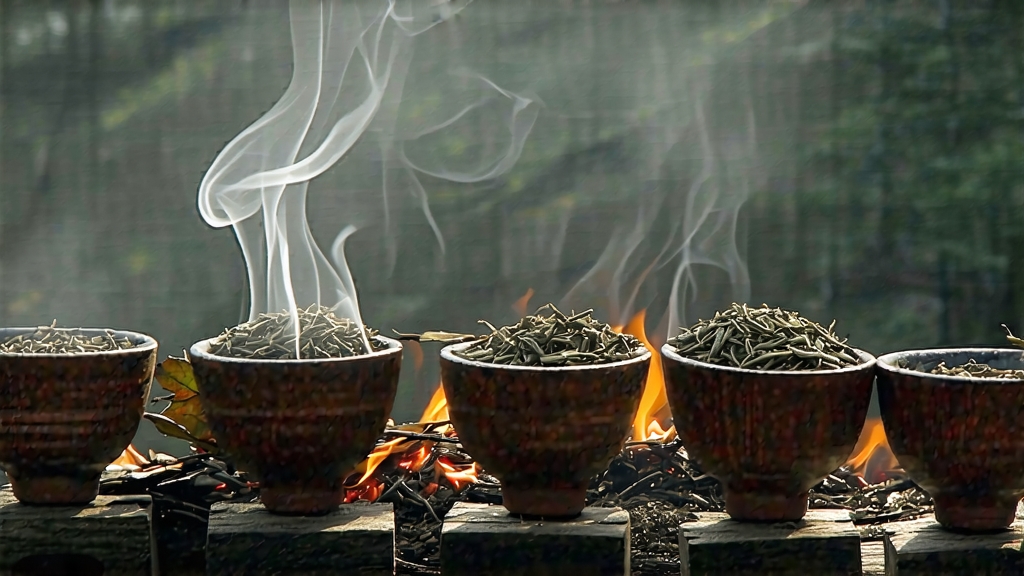
If every family tree has a founding ancestor, then Lapsang Souchong—called Zheng Shan Xiao Zhong in its Wuyishan homeland—sits at the very root of the Camellia sinensis var. sinensis black-tea lineage. First documented in 1610 by Dutch traders who bought it from Fujian merchants anchored at Batavia (today’s Jakarta), this rugged, smoke-kissed leaf was the first Chinese hong cha ever to reach Europe, predating Keemun by two centuries and Assam’s colonial plantations by even more. The English word “bohea,” once a generic label for all Chinese black teas, is simply a corruption of “Wuyi,” the granite massif where Lapsang Souchong was born. In short, when seventeenth-century Londoners poured their first cups of “black tea,” the liquor swirling in porcelain bowls was Lapsang Souchong.
Geographically, the tea is inseparable from the Wuyi Mountains, a UNESCO World Heritage Site whose 36 towering peaks and 99 winding valleys create a unique microclimate: morning mist rising from the Jiuqu (Nine-Bend) River traps cool moisture, while short sun hours and temperature swings between day and night slow leaf growth, concentrating amino acids and volatile aromatics. Only leaves picked within the 60 km² core scenic zone—defined by the town of Tongmu Guan and three surrounding villages—may legally bear the name Zheng Shan (“Original Mountain”) Xiao Zhong. Anything else is simply “smoked black tea,” no matter how fragrant the pinewood.
Two distinct styles now share the Lapsang moniker. Traditional Lapsang Souchong is withered over towering pine fires, rolled, fully oxidized, then hot-smoked in bamboo baskets suspended above glowing embers of Masson pine and cedar. The process gifts the leaf its signature tarry-sweet perfume reminiscent of single-malt Islay whisky, dried longan, and campfire-toasted marshmallow. In 2005, however, a team of local researchers led by Jiang Shuanggui developed an unsmoked version called “No-Smoke Xiao Zhong,” aiming to capture the Wuyi terroir without the polarizing pine note. Finished in electric ovens at 80 °C, this newer style reveals malt, cacao, and wild-flower honey, allowing international palates to taste the rock-ribbed minerality that underlies both expressions.
Harvest follows the Chinese solar calendar. Pre-Qingming buds—plucked before April 5—yield the most tender, subtly smoky lots coveted by German and Japanese buyers. The bulk leaf arrives in late April to early May, when two leaves and a bud are snipped at 9 a.m., after dew evaporation but before the noon sun wilts the cells. Once in the factory, leaves are spread 3 cm deep on bamboo trays set 1.8 m above pinewood hearths. A gentle smoke-wither lasting 8–10 hours reduces moisture from 75 % to 45 % while impregnating the leaf with guaiacol and syringol, the same phenols that flavor smoked paprika. Rolling follows the “pine board press” technique: 6 kg of withered leaf are wrapped in cloth, trodden by barefoot rollers who shuffle in a 360° circle, rupturing cells without macerating them. Oxidation proceeds in cedar-lined wooden boxes at 24 °C and 85 % humidity; 90 minutes of monitored browning convert catechins into theaflavins and thearubigins, painting the leaf a coppery rust. Finally, the “double smoke” phase locks in aroma: baskets of semi-dry leaf are placed 70 cm above resin-rich pine roots that burn at 200 °C for three minutes, rested, then smoked again at 160 °C for two minutes. The finished tea rests one month in earthenware jars so phenolic compounds marry the leaf’s innate sugars, rounding sharp edges.
Gongfu brewing best reveals the tea’s layered personality. Use a 120 ml porcelain gaiwan or Zhu-ni Yixing teapot; pre-heat with 95 °C water, then add 5 g of leaf—roughly two heaping teaspoons. Rinse for three seconds to awaken the leaf and discard; the first proper infusion lasts five seconds, followed by incremental increases of two seconds per steep. A quality Zheng Shan will yield 8–10 brews: the